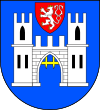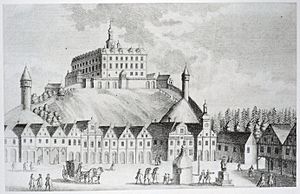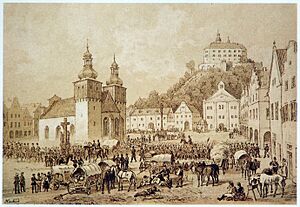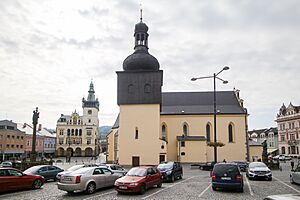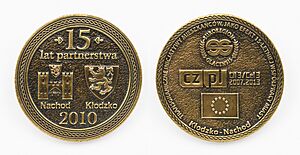Náchod facts for kids
Quick facts for kids
Náchod
|
|||
|---|---|---|---|
|
Town
|
|||
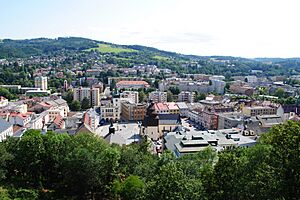
View from the castle
|
|||
|
|||
| Country | |||
| Region | Hradec Králové | ||
| District | Náchod | ||
| First mentioned | 1254 | ||
| Area | |||
| • Total | 33.34 km2 (12.87 sq mi) | ||
| Elevation | 346 m (1,135 ft) | ||
| Population
(2024-01-01)
|
|||
| • Total | 20,036 | ||
| • Density | 600.96/km2 (1,556.48/sq mi) | ||
| Time zone | UTC+1 (CET) | ||
| • Summer (DST) | UTC+2 (CEST) | ||
| Postal code |
547 01
|
||
Náchod is a cool town in the Hradec Králové Region of the Czech Republic. It's home to about 20,000 people. Náchod is famous for its beautiful sights and busy industries. The old part of town, especially the castle, is very well-preserved. It's even protected by law as a special "urban monument zone."
Contents
Exploring Náchod's Parts
Náchod is made up of several smaller areas and villages. These include Babí, Běloves, Bražec, Dobrošov, Jizbice, Lipí, Malé Poříčí, Pavlišov, and Staré Město nad Metují. Each part adds to the town's unique character.
Where is Náchod?
Náchod is located about 31 kilometers (19 miles) northeast of Hradec Králové. It sits right on the border with Poland. The town is nestled in a valley, with the Metuje river flowing through it. The area is part of the Orlické Foothills. The highest point nearby is Malinová hora, which stands at 637 meters (2,090 feet) above sea level. You can also find two fishponds, Podborný and Odkaliště, in the northwest.
A Look Back in Time: Náchod's History
Náchod started as a small settlement called Branka, meaning "Gate." It was near an important land crossing. In the mid-1200s, a knight named Hron of Načeradec built a castle here. A town then grew around the castle. This was done to protect an old trade route that went from Prague to Kłodzko Land. The first time Náchod was mentioned in writing was in 1254. By the early 1300s, the town had strong walls and towers for defense.
Many important people owned the castle over the years. These included kings like John of Bohemia and George of Poděbrady. During the Hussite Wars, a big conflict, Náchod was taken over by the Hussites. The castle grew into a large fortress. In 1544, the rich Smiřický family bought the castle. They turned it into a fancy Renaissance home. The town also thrived during this time, getting special rights almost like a royal town.
The Thirty Years' War in the 1600s was a tough time for Náchod. The Smiřický family lost their property because they supported the losing side. The land was then sold to the Trčka of Lípa family. Later, in 1634, the Emperor gave the land to his general, Ottavio Piccolomini. This Italian family owned Náchod next. The town faced military actions and changes in religion. However, it also saw some improvements. The castle was rebuilt in a grand Baroque style. The first street in town was paved in 1638. After a big fire in 1663, a new town hall was built. The Church of St. Lawrence was also rebuilt.
The Piccolomini family line ended in 1783. The Náchod area was then inherited by the Desfours family. In 1792, they sold it to Duke Peter von Biron. He brought more culture to Náchod, even starting a theater at the castle. When the duke passed away in 1800, his daughter Katharina Wilhelmine inherited Náchod. After her death, the princes of Schaumburg-Lippe bought the castle. They owned it until 1945.
The mid-1800s brought big changes. The town got an elected council. Industry and schools grew quickly. Many new buildings went up, like the Neo-Renaissance town hall and the Art Nouveau theater. A railway was built, and the textile industry boomed from 1882. Náchod became a major cotton industry center in Austria-Hungary. At the start of the 1900s, Náchod was even called the "Manchester of the east."
Before World War II, strong border defenses were built around Náchod. These were to protect Czechoslovakia from a possible German invasion. During World War II, Germany occupied the town. Náchod had very few German residents at that time.
Náchod's Economy
Today, most people in Náchod work in the service industry. Tourism is very important for the town's economy. The biggest employer is the local hospital. Some large industrial companies here make electric motors, like ATAS elektromotory Náchod and Ametek elektromotory. There's also Rubena Náchod, a rubber factory.
The town still has a textile industry tradition. Bartoň – textil, a cotton-weaving mill founded in 1867, is still operating. The Primátor Brewery, started in 1872, also has a long history.
Getting Around Náchod
Náchod is an important transport hub. There's a road border crossing with Poland called Náchod / Kudowa Słone. The I/33 road, which is part of the European route E67, connects Hradec Králové to Náchod and the border. Another main road, I/14, also runs through the town.
Náchod is also on two railway lines: Broumov–Starkoč and Týniště nad Orlicí–Teplice nad Metují. The town has three train stations and stops: Náchod, Náchod zastávka, and Náchod-Běloves.
Cool Places to See in Náchod
Náchod Castle
Náchod Castle is the most famous landmark in town. The state has owned it since 1945. You can visit the castle's inside rooms. They show off collections from Prince Ottavio Piccolomini's time, like old tapestries. You can also see collections of medals and coins. Don't miss the Gothic cellars and the tall observation tower. The castle even has a moat with bears, which is the biggest bear enclosure in the country!
Churches and Old Buildings
The Church of Saint Lawrence is right in the middle of Masarykovo Square. It was first mentioned in 1350 and rebuilt in the late 1500s.
The Church of Saint Michael the Archangel was built between 1709 and 1716 in a beautiful Baroque style.
The Church of Saint John the Baptist is in Staré Město nad Metují. It was built in the 1200s in the Gothic style. It was updated several times over the centuries. Since 1791, it has been used as a cemetery church.
The Spa in Běloves
The village of Běloves was once famous for its spa. People knew about its healing water as early as 1392. The spa opened in 1818 but closed in 1996. Even though the old spa buildings are not in use, the town built a small colonnade. It has two mineral springs and an exhibit about the spa's history. This new area opened in December 2019.
Famous People from Náchod
- Jan Letzel (1880–1925), an architect
- Jan Roth (1899–1972), a cinematographer
- Václav Černý (1905–1987), a writer and literary expert
- Josef Týfa (1913–2007), a type designer
- Luba Skořepová (1923–2016), an actress
- Josef Škvorecký (1924–2012), a writer
- Petr Skrabanek (1940–1994), a doctor
- Josef Tošovský (born 1950), an economist and former prime minister
- Václav Kotal (born 1952), a football player and manager
- Libor Michálek (born 1968), an economist and politician
- Vratislav Lokvenc (born 1973), a footballer
- Pavel Bělobrádek (born 1976), a politician
- Martin Štěpánek (born 1977), a freediver
- Petr Schwarz (born 1991), a footballer
Náchod's Sister Cities
Náchod has special friendships with other towns around the world. These are called "sister cities."
 Bauska, Latvia
Bauska, Latvia Halberstadt, Germany
Halberstadt, Germany Kudowa-Zdrój, Poland
Kudowa-Zdrój, Poland Kłodzko, Poland
Kłodzko, Poland Partizánske, Slovakia
Partizánske, Slovakia Persan, France
Persan, France Tiachiv, Ukraine
Tiachiv, Ukraine Warrington, England, United Kingdom
Warrington, England, United Kingdom
Images for kids
See also
 In Spanish: Náchod para niños
In Spanish: Náchod para niños



